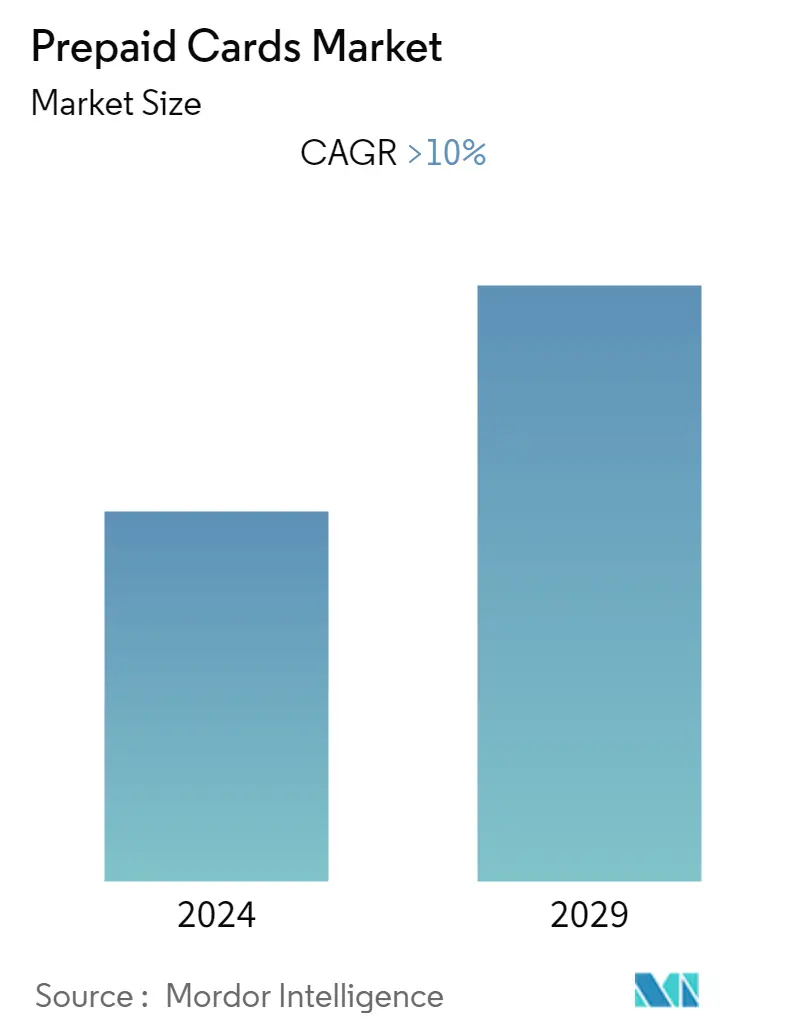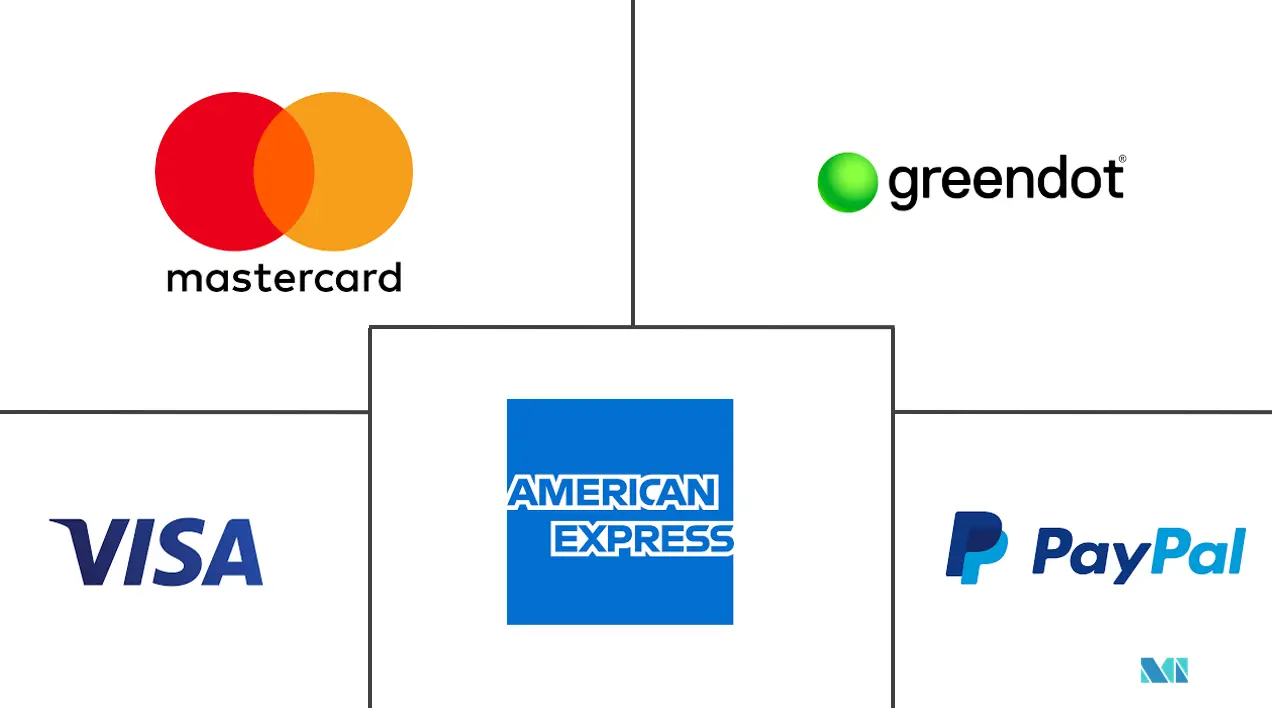Market Size of Prepaid Cards Industry

| Study Period | 2019 - 2029 |
| Base Year For Estimation | 2023 |
| Forecast Data Period | 2024 - 2029 |
| Historical Data Period | 2019 - 2022 |
| CAGR | > 10.00 % |
| Market Concentration | Medium |
Major Players
*Disclaimer: Major Players sorted in no particular order |
Europe Prepaid Card Market Analysis
The prepaid card industry has grown significantly in recent years, but due to the onset of the COVID-19 pandemic, the market is expected to drop dramatically in 2020. This is due to a rise in remote working and social distancing, which makes prepaid cards in retail, corporate, and other sectors difficult to use for shopping, travel, and cash flow. Prepaid cards, coupons, and other forms of payment have disappeared due to these circumstances. Distinct modes of working have been seen to bring different ways of communication. Businesses face a problem in ensuring that clients purchasing certificates at this time are bringing in immediate income.
The prepaid card sector is predicted to rise rapidly during the projection period. The rise in demand for cash alternatives, the rise in the number of internet users, and the rise in acceptance of prepaid cards owing to the ability to add money through different channels are all factors influencing the market's growth. Furthermore, the market's expansion is hampered by a lack of standardization. Furthermore, future market growth is likely to be boosted by an increase in the unbanked and underbanked population. During the forecast period, each of these variables is expected to significantly influence the total prepaid card market growth.
Europe Prepaid Card Industry Segmentation
Where consumers or companies prefer to utilize an electronic means of payment without attaching the payment to a credit or debit account, prepaid cards have replaced cash, checks, and other payment cards. However, various taxes and security concerns are projected to limit market expansion. Europe Prepaid Card Market segmented By Card Type (Multi-Purpose, Single-purpose), Vertical (Retail, Corporate Institutions, Government, Financial Institutions & Others), Usage (General Purpose Reloadable Cards, Gift Card, Government Benefits Disbursement Card, Incentive Payroll Card), Geography (Germany, France, the United Kingdom, Russia, Netherlands, and Spain).
| By Card Type | |
| Multi-Purpose | |
| Single-purpose |
| By Vertical | |
| Retail | |
| Corporate Institutions | |
| Government | |
| Financial Institutions & Others |
| By Usage | |
| General Purpose Reloadable Cards | |
| Gift Card | |
| Government Benefits Disbursement Card | |
| Incentive Payroll Card |
| By Geography | |
| Germany | |
| France | |
| United Kingdom | |
| Russia | |
| Netherlands | |
| Spain |
Prepaid Cards Market Size Summary
The prepaid card market in Europe is poised for significant growth, driven by increasing demand for cash alternatives and the rising number of internet users. Despite a temporary setback due to the COVID-19 pandemic, which hindered the use of prepaid cards in various sectors, the market is expected to rebound. The ability to add funds through multiple channels and the appeal of low-risk investments have made prepaid cards an attractive option for consumers. However, the market faces challenges such as a lack of standardization, which could impede its expansion. The growing acceptance of prepaid cards among the unbanked and underbanked populations presents a promising opportunity for market players, as spending patterns shift and more consumers explore cashless transaction options.
The European prepaid card industry is also benefiting from technological advancements and product innovations, with key players like Visa, Mastercard, PayPal, American Express, and Green Dot Corporation leading the charge. These companies are focusing on enhancing their production capacities and expanding their product offerings to meet the evolving needs of consumers and businesses. Initiatives such as PayPal's expansion of contactless technology and American Express's support for small businesses in France highlight the industry's commitment to facilitating cashless transactions. Collaborations, like the one between Mastercard and Microsoft, aim to improve online shopping experiences and combat digital fraud, further contributing to the market's growth trajectory.
Prepaid Cards Market Size - Table of Contents
-
1. MARKET DYNAMICS AND INSIGHTS
-
1.1 Market Overview
-
1.2 Market Drivers
-
1.3 Market Restraints
-
1.4 Insights on Various Regulatory Trends
-
1.5 Insights on impact of technology and innovation
-
1.6 Industry Attractiveness - Porters' Five Forces Analysis
-
1.6.1 Threat of New Entrants
-
1.6.2 Bargaining Power of Buyers
-
1.6.3 Bargaining Power of Suppliers
-
1.6.4 Threat of Substitutes
-
1.6.5 Intensity of Competitive Rivalry
-
-
1.7 Impact of COVID-19 on the Market
-
-
2. MARKET SEGMENTATION
-
2.1 By Card Type
-
2.1.1 Multi-Purpose
-
2.1.2 Single-purpose
-
-
2.2 By Vertical
-
2.2.1 Retail
-
2.2.2 Corporate Institutions
-
2.2.3 Government
-
2.2.4 Financial Institutions & Others
-
-
2.3 By Usage
-
2.3.1 General Purpose Reloadable Cards
-
2.3.2 Gift Card
-
2.3.3 Government Benefits Disbursement Card
-
2.3.4 Incentive Payroll Card
-
-
2.4 By Geography
-
2.4.1 Germany
-
2.4.2 France
-
2.4.3 United Kingdom
-
2.4.4 Russia
-
2.4.5 Netherlands
-
2.4.6 Spain
-
-
Prepaid Cards Market Size FAQs
What is the current Prepaid Cards Market size?
The Prepaid Cards Market is projected to register a CAGR of greater than 10% during the forecast period (2024-2029)
Who are the key players in Prepaid Cards Market?
Visa , Mastercard, PayPal Holdings Inc., American Express Company and Green Dot Corporation are the major companies operating in the Prepaid Cards Market.

